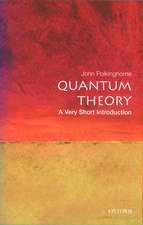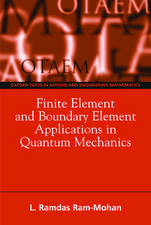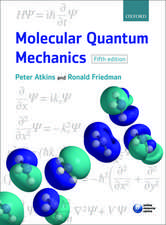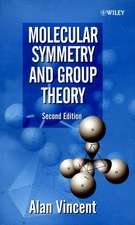Applications of Quantum Dynamics in Chemistry: Lecture Notes in Chemistry, cartea 98
Autor Fabien Gatti, Benjamin Lasorne, Hans-Dieter Meyer, André Nautsen Limba Engleză Hardback – 7 sep 2017
Assuming a basic knowledge about quantum mechanics, the authors link their explanations to recent experimental investigations where Molecular Quantum Dynamics proved successful and necessary for the understanding of the experimental results. Examples including reactive scattering, photochemistry, tunneling, femto- and attosecond chemistry and spectroscopy, cold chemistry or crossed-beam experiments illustrate the power of the method. The book restricts complicated formalism to the necessary and in a self-contained and clearly explained way, offering the reader an introduction to, and instructions for, practical exercises. Continuative explanation and math are optionally supplemented for the interested reader.
The reader learns how to apply example simulations with the MCTDH program package (Multi Configuration Time Dependent Hartree calculations). Readers can thus obtain the tools to run their own simulations and apply them to their problems. Selected scripts and program code from the examples are made available as supplementary material.
This book bridges the gap between the existing textbooks on fundamental theoretical chemistry and research monographs focusing on sophisticated applications. It is a must-read for everyone who wants to gain a sound understanding of Molecular Quantum Dynamics simulations and to obtain basic experience in running their own simulations.
| Toate formatele și edițiile | Preț | Express |
|---|---|---|
| Paperback (1) | 745.15 lei 38-44 zile | |
| Springer International Publishing – 9 sep 2018 | 745.15 lei 38-44 zile | |
| Hardback (1) | 957.75 lei 43-57 zile | |
| Springer International Publishing – 7 sep 2017 | 957.75 lei 43-57 zile |
Din seria Lecture Notes in Chemistry
-
 Preț: 96.74 lei
Preț: 96.74 lei - 18%
 Preț: 1123.35 lei
Preț: 1123.35 lei - 18%
 Preț: 776.72 lei
Preț: 776.72 lei - 18%
 Preț: 779.57 lei
Preț: 779.57 lei - 18%
 Preț: 1005.74 lei
Preț: 1005.74 lei - 18%
 Preț: 997.88 lei
Preț: 997.88 lei - 18%
 Preț: 1004.00 lei
Preț: 1004.00 lei - 18%
 Preț: 1136.30 lei
Preț: 1136.30 lei - 18%
 Preț: 1117.03 lei
Preț: 1117.03 lei - 18%
 Preț: 1006.55 lei
Preț: 1006.55 lei - 18%
 Preț: 903.62 lei
Preț: 903.62 lei -
 Preț: 377.73 lei
Preț: 377.73 lei -
 Preț: 395.63 lei
Preț: 395.63 lei - 18%
 Preț: 728.43 lei
Preț: 728.43 lei - 18%
 Preț: 782.57 lei
Preț: 782.57 lei - 18%
 Preț: 1112.78 lei
Preț: 1112.78 lei - 15%
 Preț: 688.13 lei
Preț: 688.13 lei - 15%
 Preț: 646.62 lei
Preț: 646.62 lei -
 Preț: 393.35 lei
Preț: 393.35 lei - 18%
 Preț: 1124.30 lei
Preț: 1124.30 lei -
 Preț: 384.86 lei
Preț: 384.86 lei -
 Preț: 383.71 lei
Preț: 383.71 lei -
 Preț: 378.71 lei
Preț: 378.71 lei -
 Preț: 384.09 lei
Preț: 384.09 lei -
 Preț: 387.42 lei
Preț: 387.42 lei -
 Preț: 388.90 lei
Preț: 388.90 lei -
 Preț: 393.35 lei
Preț: 393.35 lei -
 Preț: 384.09 lei
Preț: 384.09 lei -
 Preț: 377.73 lei
Preț: 377.73 lei -
 Preț: 382.95 lei
Preț: 382.95 lei -
 Preț: 384.70 lei
Preț: 384.70 lei - 15%
 Preț: 644.63 lei
Preț: 644.63 lei -
 Preț: 386.00 lei
Preț: 386.00 lei -
 Preț: 389.70 lei
Preț: 389.70 lei -
 Preț: 384.09 lei
Preț: 384.09 lei -
 Preț: 385.25 lei
Preț: 385.25 lei -
 Preț: 392.21 lei
Preț: 392.21 lei -
 Preț: 386.00 lei
Preț: 386.00 lei -
 Preț: 403.37 lei
Preț: 403.37 lei -
 Preț: 378.71 lei
Preț: 378.71 lei -
 Preț: 383.50 lei
Preț: 383.50 lei -
 Preț: 390.63 lei
Preț: 390.63 lei -
 Preț: 389.31 lei
Preț: 389.31 lei
Preț: 957.75 lei
Preț vechi: 1167.99 lei
-18% Nou
Puncte Express: 1437
Preț estimativ în valută:
183.26€ • 191.86$ • 151.64£
183.26€ • 191.86$ • 151.64£
Carte tipărită la comandă
Livrare economică 07-21 aprilie
Preluare comenzi: 021 569.72.76
Specificații
ISBN-13: 9783319539218
ISBN-10: 3319539213
Pagini: 372
Ilustrații: XVI, 429 p. 110 illus.
Dimensiuni: 155 x 235 mm
Greutate: 0.8 kg
Ediția:1st ed. 2017
Editura: Springer International Publishing
Colecția Springer
Seria Lecture Notes in Chemistry
Locul publicării:Cham, Switzerland
ISBN-10: 3319539213
Pagini: 372
Ilustrații: XVI, 429 p. 110 illus.
Dimensiuni: 155 x 235 mm
Greutate: 0.8 kg
Ediția:1st ed. 2017
Editura: Springer International Publishing
Colecția Springer
Seria Lecture Notes in Chemistry
Locul publicării:Cham, Switzerland
Cuprins
Part I Introduction.- Part II Concepts and Methods: Quantum effects.- Electronic states and potential energy operators.- The Choice of coordinates.- Kinetic energy operators.- Introduction to molecular symmetry.- Introduction to numerical methods and to MCTDH.- Part III Applications: Infrared spectroscopy.- Quantum control with laser pulses in the electronic ground state.- Photodissociation spectra.- Cross sections for reactive scattering.- Quantum control with laser pulses for electronically excited states.- Non-adiabatic photochemistry.- Optimal control and quantum computers.- Part IV Conclusion.
Notă biografică
Fabien Gatti (Montpellier, France) has a background in chemistry and theoretical quantum physics. He has experience in teaching the foundations of quantum mechanics to chemistry students at the bachelor level, advanced quantum mechanics and molecular quantum dynamics to physics and chemistry students at masters level. Gatti often organizes courses on molecular quantum dynamics in summer schools for PhD students, postdocs and researchers, including practical computer lab sessions, where the participants learn to run their own simulations with the Multi Configuration Time Dependent Hartree program package (MCTDH).
Fabien Gatti it the editor of successful books about Molecular Quantum Dynamics and the MCTDH package, for specialists as well as for practitioners. His latest book “Molecular Quantum Dynamics: From Theory to Applications” is published in Springer’s series “Physical Chemistry in Action” and illustrates the power of this method for actual problems in modern physical-chemicalresearch, containing contributions and examples by the world renowned experts.
Benjamin Lasorne is a collaborator with Fabien Gatti in Montpellier. He has a strong background in physical and theoretical chemistry and teaches theoretical chemistry to bachelor and master’s students in chemistry, as well as theoretical photochemistry using molecular quantum dynamics in summer schools.
Hans-Dieter Meyer (Heidelberg, Germany) has a longstanding experience with the MCTDH methodology. He has a successful collaboration with Fabien Gatti, together with G. Worth they have edited the first book on Multidimensional Quantum Dynamics: MCTDH Theory and Applications.
André Nauts is emeritus Professor at the Université Catholique de Louvain, from which he also graduated in pharmacy and with a master’s and PhD degree in physics. His research interests are in molecular quantum dynamics and spectroscopy. His long teaching experiences spans from mathematics, over basic and statistical physics, to quantum mechanics and molecular physics. In the recent years, an intensive teaching collaboration has connected the activities and courses by André Nauts and Fabien Gatti, combining an introduction to the fundamentals with hands-on practical works in MCTDH example simulations.
Fabien Gatti it the editor of successful books about Molecular Quantum Dynamics and the MCTDH package, for specialists as well as for practitioners. His latest book “Molecular Quantum Dynamics: From Theory to Applications” is published in Springer’s series “Physical Chemistry in Action” and illustrates the power of this method for actual problems in modern physical-chemicalresearch, containing contributions and examples by the world renowned experts.
Benjamin Lasorne is a collaborator with Fabien Gatti in Montpellier. He has a strong background in physical and theoretical chemistry and teaches theoretical chemistry to bachelor and master’s students in chemistry, as well as theoretical photochemistry using molecular quantum dynamics in summer schools.
Hans-Dieter Meyer (Heidelberg, Germany) has a longstanding experience with the MCTDH methodology. He has a successful collaboration with Fabien Gatti, together with G. Worth they have edited the first book on Multidimensional Quantum Dynamics: MCTDH Theory and Applications.
André Nauts is emeritus Professor at the Université Catholique de Louvain, from which he also graduated in pharmacy and with a master’s and PhD degree in physics. His research interests are in molecular quantum dynamics and spectroscopy. His long teaching experiences spans from mathematics, over basic and statistical physics, to quantum mechanics and molecular physics. In the recent years, an intensive teaching collaboration has connected the activities and courses by André Nauts and Fabien Gatti, combining an introduction to the fundamentals with hands-on practical works in MCTDH example simulations.
Textul de pe ultima copertă
This book explains the usage and application of Molecular Quantum Dynamics, the methodology where both the electrons and the nuclei in a molecule are treated with quantum mechanical calculations. This volume of Lecture Notes in Chemistry addresses graduate students and postdocs in the field of theoretical chemistry, as well as postgraduate students, researchers and teachers from neighboring fields, such as quantum physics, biochemistry, biophysics, or anyone else who is interested in this rising method in theoretical chemistry, and who wants to gain experience in the opportunities it can offer. It can also be useful for teachers interested in illustrative examples of time-dependent quantum mechanics as animations of realistic wave packets have been designed to assist in visualization.
Assuming a basic knowledge about quantum mechanics, the authors link their explanations to recent experimental investigations where Molecular Quantum Dynamics proved successful and necessary for the understanding of the experimental results. Examples including reactive scattering, photochemistry, tunneling, femto- and attosecond chemistry and spectroscopy, cold chemistry or crossed-beam experiments illustrate the power of the method. The book restricts complicated formalism to the necessary and in a self-contained and clearly explained way, offering the reader an introduction to, and instructions for, practical exercises. Continuative explanation and math are optionally supplemented for the interested reader.
The reader learns how to apply example simulations with the MCTDH program package (Multi Configuration Time Dependent Hartree calculations). Readers can thus obtain the tools to run their own simulations and apply them to their problems. Selected scripts and program code from the examples are made available as supplementary material.
This book bridges the gap between the existing textbooks on fundamental theoretical chemistry and research monographs focusing on sophisticated applications. It is a must-read for everyone who wants to gain a sound understanding of Molecular Quantum Dynamics simulations and to obtain basic experience in running their own simulations.
Assuming a basic knowledge about quantum mechanics, the authors link their explanations to recent experimental investigations where Molecular Quantum Dynamics proved successful and necessary for the understanding of the experimental results. Examples including reactive scattering, photochemistry, tunneling, femto- and attosecond chemistry and spectroscopy, cold chemistry or crossed-beam experiments illustrate the power of the method. The book restricts complicated formalism to the necessary and in a self-contained and clearly explained way, offering the reader an introduction to, and instructions for, practical exercises. Continuative explanation and math are optionally supplemented for the interested reader.
The reader learns how to apply example simulations with the MCTDH program package (Multi Configuration Time Dependent Hartree calculations). Readers can thus obtain the tools to run their own simulations and apply them to their problems. Selected scripts and program code from the examples are made available as supplementary material.
This book bridges the gap between the existing textbooks on fundamental theoretical chemistry and research monographs focusing on sophisticated applications. It is a must-read for everyone who wants to gain a sound understanding of Molecular Quantum Dynamics simulations and to obtain basic experience in running their own simulations.
Caracteristici
Explains Molecular Quantum Dynamics simulations in a self-contained way, offering instructions for example simulations Supplemented by scripts and code available for download, with which the reader can follow the examples and execute own simulations Bridges the gap between textbooks on fundamental theoretical chemistry and research monographs on sophisticated theoretical-chemical methods and results Illustrates the explanations with selected examples, making a firm connection to experiments where Molecular Quantum Dynamics are needed for the understanding and explanation of experimental results Including a foreword by Jean Dalibard Includes supplementary material: sn.pub/extras












